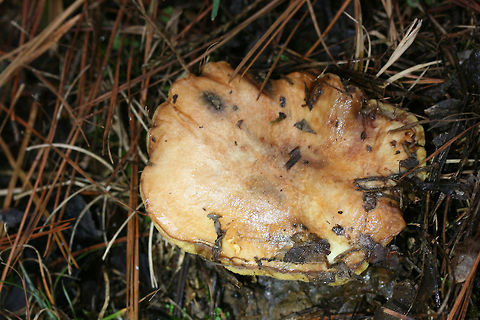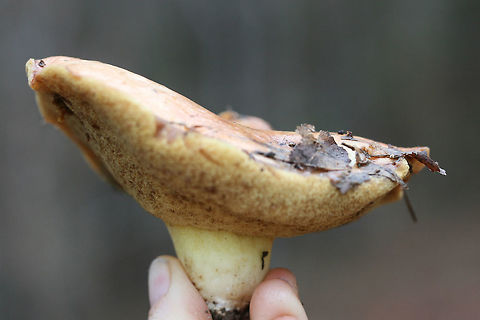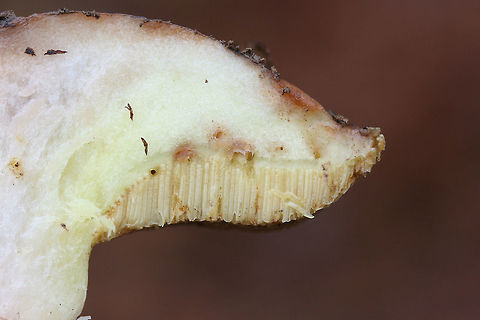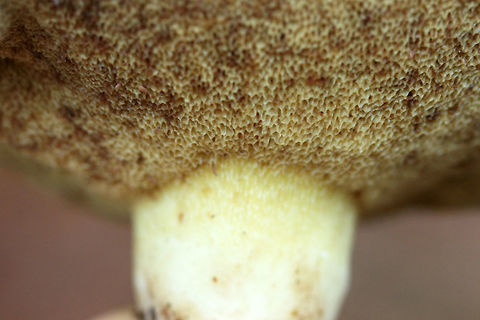
Appearance
The cap is deep brown to reddish-brown, later fading to tan with age, and it does not bruise with handling. The cap surface is smooth, and, depending on the moisture in the environment, may range from sticky to the touch to slimy. Depending on its maturity, the cap shape may range from spherical to broadly convex. The cap diameter measures 5–10 cm , and the cap cuticle can be peeled from the surface. The tubes are yellow, becoming olive-green with age, and they have an attachment to the stipe that ranges from adnate to decurrent . They are typically up to 1 cm deep, and there are about 1–2 tube mouths per millimeter. The pores are pale yellow, round, 1–2 mm wide, and do not change color when bruised.The stipe is white to pale yellow, dry, solid, not bruising, and pruinose . A characteristic feature of many ''Suillus'' species are the glandular dots found on the stipe—clumps of hyphal cell ends through which the fungus secretes various metabolic wastes, leaving a sticky or resinous "dot". In ''S. brevipes'', the form of the glandular dots is variable: they may be absent, slightly underdeveloped or obscurely formed with age. The stipe is usually short in comparison to the diameter of the cap, typically 2–6 cm long and 1–2 cm thick. It is either of equal width throughout, or may taper downwards; its surface bears minute puncture holes at maturity, and is it slightly fibrous at the base. Collections made in New Zealand tend to have a reddish coloration at the very base of the stipe. The flesh of the mushroom is initially white, but turns pale yellow in age. The odor and taste are mild. The spore print is cinnamon-brown.The spores are elliptical to oblong, smooth, and have dimensions of 7–10 by 3–4 µm. The spore-bearing cells, the basidia, are thin-walled, club-shaped to roughly cylindrical, and measure 2–25 by 5–7 µm. They bear either two or four spores. The pleurocystidia are roughly cylindrical with rounded ends, thin-walled, and 40–55 by 5–8 µm. The cells often have brown contents, and in the presence of 2% potassium hydroxide will appear hyaline or vinaceous ; in Melzer's reagent they become pale yellow or brown. The cheilocystidia are 30–60 by 7–10 µm, club-shaped to almost cylindrical, thin-walled, with brown incrusting material at the base, and arranged like a bundle of fibers. In KOH they appear hyaline, and are pale yellow in Melzer's reagent. Caulocystidia are 60–90 by 7–9 µm, mostly cylindrical with rounded ends, and arranged in bundles with brown pigment particles at the base. The caulocystidia stain vinaceous in KOH. The cuticle of the cap is made of a layer of interwoven gelatinous hyphae that are individually 2–5 µm thick; the gelatinous hyphae are responsible for the sliminess of the cuticle. There are no clamp connections in the hyphae.

Naming
Several ''Suillus'' species which grow under pines could be confused with ''S. brevipes''. ''S. granulatus'' has a longer stipe, and distinct raised granules on the stipe. ''S. brevipes'' is differentiated from ''S. albidipes'' by not having a cottony roll of velar tissue at the margin when young. ''S. pallidiceps'' is by distinguished its pale yellow cap color; and ''S. albivelatus'' has a veil. ''S. pungens'' has a characteristic pungent odor, compared to the mild smell of ''S. brevipes'', and like ''S. granulatus'', has glandular dots on the stipe.
Distribution
''Suillus brevipes'' grows singly, scattered, or in groups on the ground in late summer and autumn. A common—and sometimes abundant—mushroom, it occurs over most of North America , south to Mexico, and north to Canada. This species has been found in Puerto Rico growing under planted ''Pinus caribaea'', where it is thought to have been introduced inadvertently from North Carolina by the USDA Forest Service in 1955. Other introductions have also occurred in exotic pine plantations in Argentina, India, New Zealand, Japan, and Taiwan.
Habitat
''Suillus brevipes'' is a mycorrhizal fungus, and it develops a close symbiotic association with the roots of various tree species, especially pine. The underground mycelia form a sheath around the tree rootlets, and the fungal hyphae penetrate between the cortical cells of the root, forming ectomycorrhizae. In this way, the fungus can supply the tree with minerals, while the tree reciprocates by supplying carbohydrates created by photosynthesis. In nature, it associates with two- and three-needle pines, especially lodgepole and ponderosa pine. Under controlled laboratory conditions, the fungus has been shown to form ectomycorrhizae with ponderosa, lodgepole, loblolly, eastern white, patula, pond, radiata, and red pines. ''In vitro'' mycorrhizal associations formed with non-pine species include Pacific madrone, bearberry, western larch, Sitka spruce, and coast Douglas-fir. Fungal growth is inhibited by the presence of high levels of the heavy metals cadmium , lead , and nickel .During the regrowth of pine trees after disturbance like clearcutting or wildfire, there appears an orderly sequence of mycorrhizal fungi as one species is replaced by another. A study on the ecological succession of ectomycorrhizal fungi in Canadian jack pine forests following wildfire concluded that ''S. brevipes'' is a multi-stage fungus. It appears relatively early during tree development; fruit bodies were common in 6-year-old tree stands, and the fungus colonized the highest proportion of root tips. The fungus persists throughout the life of the tree, having been found in tree stands that were 41, 65, and 122 years old. There is, however, a relative reduction in the prevalence of the fungus with increasing stand age, which may be attributed to increased competition from other fungi, and a change in habitat brought about by closure of the forest canopy. Generally, ''S. brevipes'' responds favorably to silvicultural practices such as thinning and clearcutting. A 1996 study demonstrated that fruit bodies increased in abundance as the severity of disturbance increased. It has been suggested that the thick-walled, wiry rhizomorphs produced by the fungus may serve as an adaptation that helps it to survive and remain viable for a period of time following disturbance.''Suillus brevipes'' grows singly, scattered, or in groups on the ground in late summer and autumn. A common—and sometimes abundant—mushroom, it occurs over most of North America , south to Mexico, and north to Canada. This species has been found in Puerto Rico growing under planted ''Pinus caribaea'', where it is thought to have been introduced inadvertently from North Carolina by the USDA Forest Service in 1955. Other introductions have also occurred in exotic pine plantations in Argentina, India, New Zealand, Japan, and Taiwan.
References:
Some text fragments are auto parsed from Wikipedia.